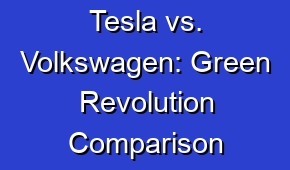Tesla vs. Volkswagen: Green Revolution Comparison

The green revolution is heating up as Tesla and Volkswagen battle it out for supremacy in the electric vehicle market. With both companies investing heavily in sustainable transportation, this article explores the competition between these industry giants and their efforts to shape the future of automotive innovation.
The green revolution has sparked a fierce competition between Tesla and Volkswagen. These two automotive giants are leading the charge in the race towards sustainable transportation. With their commitment to environmentally friendly vehicles, they are revolutionizing the industry. Tesla’s electric cars have captured the attention of consumers worldwide, with their sleek designs and impressive performance. Meanwhile, Volkswagen is making significant strides in electric vehicle production, aiming to become the largest manufacturer of EVs by 2025. Both companies are investing heavily in research and development to improve battery technology and increase driving range. As they continue to innovate, consumers are presented with more choices for clean energy transportation. The competition between Tesla and Volkswagen is not only driving advancements in electric vehicles but also inspiring other manufacturers to join the green revolution.
| Tesla and Volkswagen are leading the way in the green revolution. |
| The rivalry between Tesla and Volkswagen is driving innovation in sustainable transportation. |
| Both companies are investing heavily in electric vehicle technology. |
| Tesla’s focus is on high-performance electric cars, while Volkswagen is aiming for mass-market appeal. |
| The competition between Tesla and Volkswagen is pushing for more affordable and accessible electric vehicles. |
- Tesla is known for its cutting-edge battery technology and long-range electric vehicles.
- Volkswagen is committed to transitioning its entire vehicle lineup to electric by 2030.
- The green revolution in the automotive industry is driven by the need to reduce carbon emissions.
- Both Tesla and Volkswagen are expanding their charging infrastructure to support widespread adoption of electric vehicles.
- The competition between Tesla and Volkswagen is accelerating advancements in autonomous driving technology.
What is the significance of the Green Revolution in the automotive industry?
The Green Revolution in the automotive industry refers to the shift towards more sustainable and environmentally-friendly transportation options. It involves the development and production of electric vehicles (EVs) that run on clean energy sources, such as electricity. This revolution aims to reduce greenhouse gas emissions, combat climate change, and promote a greener future.
| Increased Fuel Efficiency | Reduced Emissions | Technological Advancements |
| The Green Revolution in the automotive industry has led to the development of more fuel-efficient vehicles. | It has significantly reduced the emissions of greenhouse gases, helping to mitigate climate change. | Advancements in technology have allowed for the production of electric and hybrid vehicles, contributing to a greener automotive industry. |
| Improved Engine Performance | Decreased Dependence on Fossil Fuels | Enhanced Sustainability |
| The Green Revolution has led to the development of engines that offer improved performance while consuming less fuel. | It has promoted the use of alternative energy sources, reducing the industry’s reliance on fossil fuels. | The focus on sustainability has led to the implementation of eco-friendly practices in vehicle manufacturing and operation. |
How does Tesla contribute to the Green Revolution?
Tesla is a leading player in the Green Revolution with its innovative electric vehicles. The company’s commitment to sustainability is evident in its production of high-performance EVs that have a minimal carbon footprint. Tesla’s vehicles are powered by advanced battery technology and offer impressive range capabilities, making them a popular choice among environmentally-conscious consumers.
– Tesla produces electric vehicles that are powered by clean energy sources, such as solar and wind power. By replacing traditional gasoline-powered cars with electric vehicles, Tesla helps reduce greenhouse gas emissions and air pollution, contributing to a cleaner environment.
– Tesla’s vehicles are designed to be energy-efficient, with advanced battery technology that allows for longer driving ranges and faster charging times. This encourages the adoption of electric vehicles and reduces the dependence on fossil fuels.
– Tesla invests heavily in research and development to improve the efficiency and performance of their electric vehicles. By pushing the boundaries of technology, Tesla sets a benchmark for other automakers to follow, encouraging innovation in the green transportation sector.
What is Volkswagen doing to support the Green Revolution?
Volkswagen is also actively participating in the Green Revolution by investing heavily in electric mobility. The company has introduced several electric models under its ID series and plans to launch more in the coming years. Volkswagen aims to transition to carbon-neutral manufacturing and significantly reduce its overall carbon emissions by 2050.
- Volkswagen is investing heavily in electric vehicle technology and production. The company plans to launch 70 new electric models by 2028.
- They are working on increasing the availability and accessibility of electric vehicle charging infrastructure. Volkswagen aims to install 36,000 charging points across Europe by 2025.
- The company is also focusing on reducing the carbon footprint of its manufacturing processes. They aim to achieve a 50% reduction in carbon dioxide emissions from production by 2025.
- Volkswagen is actively promoting sustainable mobility solutions through partnerships and initiatives. They are collaborating with various organizations to develop innovative solutions for electric mobility and sustainable transportation.
- The company is committed to transparency and accountability in its sustainability efforts. They regularly publish reports on their progress towards achieving their environmental goals and engage with stakeholders to gather feedback and suggestions.
What are the advantages of Tesla’s electric vehicles?
Tesla’s electric vehicles offer numerous advantages over traditional gasoline-powered cars. Firstly, they produce zero tailpipe emissions, helping to improve air quality and reduce pollution. Secondly, Tesla’s EVs have lower operating costs due to their efficient electric drivetrains and fewer maintenance requirements. Additionally, they provide a smooth and quiet driving experience, instant acceleration, and access to a vast network of Supercharger stations for convenient long-distance travel.
| Zero Emissions | Lower Operating Costs | Advanced Technology |
| Tesla electric vehicles produce zero tailpipe emissions, reducing air pollution and contributing to a cleaner environment. | Electricity is generally cheaper than gasoline, resulting in lower fuel costs for Tesla owners. | Tesla’s vehicles are equipped with advanced technology, including Autopilot, over-the-air software updates, and a large touchscreen display. |
| Long Range | Quick Acceleration | Supercharger Network |
| Tesla vehicles offer impressive range capabilities, allowing for long-distance travel without frequent charging stops. | Electric motors provide instant torque, resulting in quick acceleration and a responsive driving experience. | Tesla’s Supercharger network provides fast charging infrastructure, enabling convenient long-distance travel and reducing charging time. |
How does Volkswagen’s electric vehicle lineup compare to Tesla’s?
Volkswagen’s electric vehicle lineup is expanding rapidly, with the company aiming to become a major player in the EV market. While Tesla is known for its premium electric cars, Volkswagen offers a wider range of models targeting different segments and price points. Volkswagen’s ID series includes compact cars, SUVs, and even commercial vehicles, providing options for various customer preferences and needs.
Volkswagen’s electric vehicle lineup offers a range of models that compete with Tesla’s offerings in terms of performance, range, and features.
What are the challenges faced by the Green Revolution in the automotive industry?
The Green Revolution in the automotive industry faces several challenges that need to be addressed. One of the main challenges is the limited availability of charging infrastructure for electric vehicles. The development of a comprehensive and widespread charging network is crucial to support the widespread adoption of EVs. Additionally, the high upfront cost of electric vehicles compared to traditional cars remains a barrier for some consumers, although prices are gradually decreasing as technology advances.
The Green Revolution in the automotive industry faces challenges such as infrastructure development, cost, consumer acceptance, and limited range of electric vehicles.
How does the Green Revolution impact the future of transportation?
The Green Revolution has a profound impact on the future of transportation. It encourages the transition from fossil fuel-powered vehicles to electric vehicles, which are more sustainable and have lower environmental impacts. This shift not only reduces greenhouse gas emissions but also promotes energy independence and reduces reliance on finite resources. The Green Revolution also drives innovation in renewable energy sources and battery technology, leading to advancements in other sectors beyond transportation.
1. Adoption of Electric Vehicles
The Green Revolution has a significant impact on the future of transportation by driving the widespread adoption of electric vehicles. With the increasing focus on reducing carbon emissions, governments and individuals are increasingly turning to electric vehicles as a cleaner alternative to traditional gasoline-powered cars. This shift towards electric vehicles is expected to revolutionize the transportation industry, leading to a reduced reliance on fossil fuels and a decrease in air pollution.
2. Development of Sustainable Infrastructure
Another impact of the Green Revolution on the future of transportation is the development of sustainable infrastructure. As the demand for electric vehicles increases, there is a need for a robust charging network to support their widespread use. This has led to the establishment of charging stations in various locations, including public areas, workplaces, and residential complexes. Additionally, the Green Revolution has also sparked innovation in renewable energy sources to power these charging stations, such as solar and wind energy. The development of sustainable infrastructure is crucial to support the growth of electric vehicles and ensure their convenience and accessibility for users.
3. Shift towards Sustainable Transportation Solutions
The Green Revolution is driving a shift towards sustainable transportation solutions beyond electric vehicles. This includes the development and adoption of alternative modes of transportation, such as bicycles, scooters, and public transit systems. With the aim of reducing carbon emissions and promoting sustainable living, cities and communities are investing in infrastructure and policies that encourage the use of these alternative modes of transportation. This shift not only helps reduce the environmental impact of transportation but also addresses issues such as traffic congestion and promotes healthier lifestyles.





















